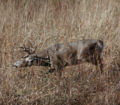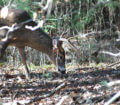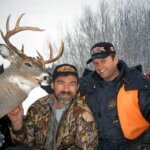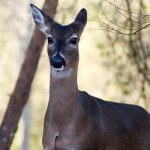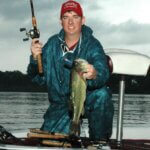Editor’s Note: Dr. Robert Sheppard of Tuscaloosa, Alabama, is the supreme student of deer and their habits. He approaches deer hunting scientifically and enjoys nothing more than gathering information about deer. This week he’s sharing with us how winds and thermals affect deer and how that impacts your deer hunting.
 I methodically check wind direction through several different methods before I finally enter my stand. The first thing I do every morning when I get up is to check my weather radio and see what the prediction for the wind direction is for that day. Each day I hunt, the wind dictates the choice of stands I have. I only will hunt out of the stands that face into the wind. I’ll have 10-20 stand sites in a region, which means I have a stand I can hunt from, regardless of the wind’s direction, on any given day. The wind is my friend as long as I know the wind’s direction. Then I begin to narrow down my choice of stands. Another factor that is added to the final decision of where I will hunt besides wind direction is how much time has passed since I’ve visited these stand sites. The two stand sites that I have hunted from the least in recent weeks will be my choices for a morning hunt.
I methodically check wind direction through several different methods before I finally enter my stand. The first thing I do every morning when I get up is to check my weather radio and see what the prediction for the wind direction is for that day. Each day I hunt, the wind dictates the choice of stands I have. I only will hunt out of the stands that face into the wind. I’ll have 10-20 stand sites in a region, which means I have a stand I can hunt from, regardless of the wind’s direction, on any given day. The wind is my friend as long as I know the wind’s direction. Then I begin to narrow down my choice of stands. Another factor that is added to the final decision of where I will hunt besides wind direction is how much time has passed since I’ve visited these stand sites. The two stand sites that I have hunted from the least in recent weeks will be my choices for a morning hunt.
But once I decide which stand I will hunt out of because of the prevailing wind, I don’t turn my brain off. When I get into my car and head for the woods, I observe every chimney I pass. I have my compass on the front seat of the car and check the direction the wind is blowing the smoke out of the chimneys. If every chimney I see has its smoke blowing in a different direction during the 15-mile drive I have to make from my house to the woods, then I begin to wonder if I’m not hunting on a day when the wind will be variable and unpredictable and/or if there are thermals affecting the air current differently from what the weatherman has reported.
 By the time I reach the woods, if I determine that the wind is variable and won’t be blowing consistently from one direction during the time I plan to hunt, then I spend my day scouting. Although many hunters will continue with their hunt plans and disregard the wind, I know to be successful I must hunt as the wind dictates. Since 80 percent of my time in the woods is spent in scouting, selecting stand sites and cutting shooting lanes, and only 20 percent of my time actually is spent in a tree, I never view the days with variable winds as wasted hunting time.
By the time I reach the woods, if I determine that the wind is variable and won’t be blowing consistently from one direction during the time I plan to hunt, then I spend my day scouting. Although many hunters will continue with their hunt plans and disregard the wind, I know to be successful I must hunt as the wind dictates. Since 80 percent of my time in the woods is spent in scouting, selecting stand sites and cutting shooting lanes, and only 20 percent of my time actually is spent in a tree, I never view the days with variable winds as wasted hunting time.
After I listen to the weather radio and check my compass on my way to my stand to see which way the chimney smoke is being blown, I next stop my car in a region that has a wide-open field on both sides of the road just before I get to where I plan to hunt. I don’t want any trees or obstructions to create a turbulence in the wind. I get out of the car and take one of my broadheads that has a piece of string tied to it, hold it out and see in which direction the wind pushes the string. Then I check the wind with my compass to make sure the wind is still blowing in the same direction that I’ve heard on the weather radio and have seen blowing from the chimneys.
 In a constant wind direction, I’ll go ahead and walk through the woods to the stand I’ve planned to hunt from that day. As I approach my tree stand, I’m also conscious that I’m walking into the wind and not with the wind at my back. Understanding the wind’s direction makes the wind my hunting friend. Once I arrive at my stand and climb into the tree, I still check the wind with the string tied to the end of my broadhead or my gun barrel and my compass. Then any time the wind changes direction or the air movement varies, I can tell which way my scent is being blown from that string.
In a constant wind direction, I’ll go ahead and walk through the woods to the stand I’ve planned to hunt from that day. As I approach my tree stand, I’m also conscious that I’m walking into the wind and not with the wind at my back. Understanding the wind’s direction makes the wind my hunting friend. Once I arrive at my stand and climb into the tree, I still check the wind with the string tied to the end of my broadhead or my gun barrel and my compass. Then any time the wind changes direction or the air movement varies, I can tell which way my scent is being blown from that string.
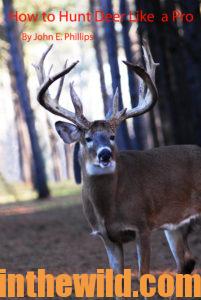
 To learn more about hunting deer, go to John E. Phillips’s book, “How to Hunt Deer Like a Pro” at https://www.amazon.com/How-Hunt-Deer-Like-Pro-ebook/dp/B007D3H08M, available in Kindle, print and Audible versions. To receive your free book on “How to Make Venison Jerky,” go to https://www.emailmeform.com/builder/form/Ece3UZVcOo52cKPJcL
To learn more about hunting deer, go to John E. Phillips’s book, “How to Hunt Deer Like a Pro” at https://www.amazon.com/How-Hunt-Deer-Like-Pro-ebook/dp/B007D3H08M, available in Kindle, print and Audible versions. To receive your free book on “How to Make Venison Jerky,” go to https://www.emailmeform.com/builder/form/Ece3UZVcOo52cKPJcL

